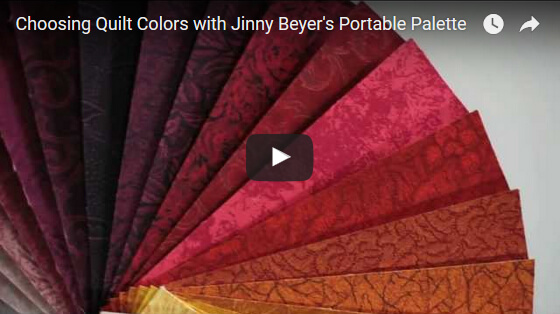
60° diamonds are extremely versatile and quilts made with them are great for hand-piecing projects.
Jinny likes to assemble the diamonds into a base unit, decide where to put lights, and go from there. The unit for Red Fort is one of the simplest, as it has only four diamonds—two lights and two darks.
Decide what size diamond you want. So many people nowadays are collecting 2½” strips and like to cut their diamonds from those strips. That is the size that was used for Red Fort. The 60° degree Perfect Cut Diamond Ruler makes cutting the diamonds a breeze. Click here to learn about using the 60° ruler.
Start off by making stacks of units. For a scrappy effect, when making the units, use different fabrics in each of the four diamonds. For the darks, Jinny usually make one of them darker than the other, and does the same for the lights. Sometimes she will mix it up, using a medium fabric as a light in one unit and as a dark in the other. As long as there is contrast between light and dark in each of the units it will work out. Jinny’s advice? Don’t try to think ahead. Just make the units!
Once you have a lot of units, lay them out into larger sections. Each of these large units will have 12 of the smaller ones. Start by making a star using six of the diamond units and then fill in with the remaining six around the edge.
Now make several of these large units depending on how big you want the quilt. The one shown here has 10 full units, four side units which are half of the larger one, five top/bottom units, and two corners (one the reverse of the other.)
The side, top/bottom and corner units use additional shapes (partial diamonds) to finish off the edges. Those shapes, for 2 ¼” or 2 ½ diamonds, are included in the free download, Red Fort Templates.
A quilt of this size, including the border shown, is 66” x 78”. A smaller quilt with five large units (two in the top row, one in the middle and two at the bottom) with the border will finish at 49” x 64”.
For the border, Jinny used a border print fabric and an accent fabric. The narrow stripe from the border is first, then an accent border, then the wider stripe from the border fabric to finish it off.
She used the Golden Gauge Calipers to determine the width of that middle, accent border.
And when it comes to putting the borders on the quilt, see our tip for achieving perfectly mitered corners — without math — when working with a rectangular quilt.
Although the Java pixie that Jinny used is no longer available, you can try this design with our other batik pixie rolls which can be found here. In addition to the Pixie Strips, Jinny has added the following fabrics:
1/2 yard each of a coordinating batik for blocks and for the inner border
2¼ yards of fabric for blocks and the outer border

































